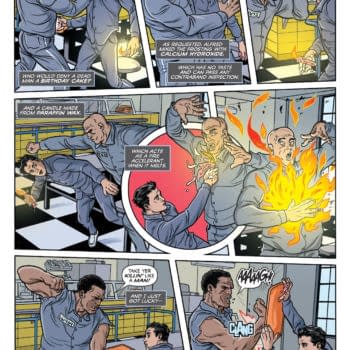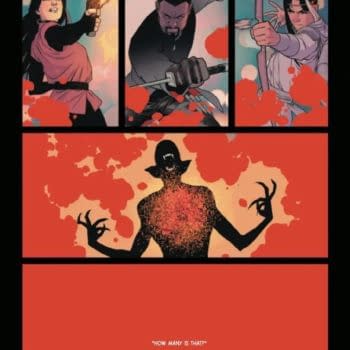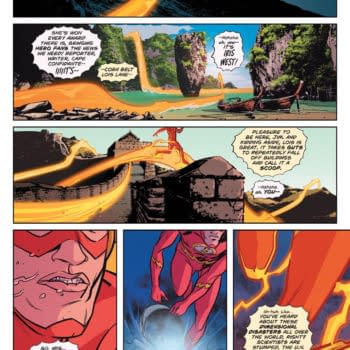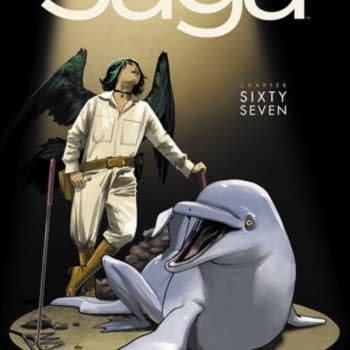Posted in: Comics, Recent Updates | Tagged: boom studios, Comics, entertainment, fox, Matías Bergara, mike johnson, sleepy hollow, Sleepy Hollow: Origins, tv
A Comic Brings Us The Origins Of Sleepy Hollow – Interrogating Mike Johnson At WonderCon
Mike Johnson was recently announced as the writer on the fan-gasmic crossover between Star Trek and Green Lantern, but exactly one day before that went live, I caught up with him to talk about his Sleepy Hollow: Origins one-shot from Boom! Studios. As a massive fan of the previous Sleepy Hollow mini-series from Boom! and someone who shamelessly pressured Boom to bring it back, I couldn't wait to get my hands on the one-shot and going to WonderCon this past weekend meant that I did, in fact, get to read it a few days early.

Sleepy Hollow: Origins is out today, April 8th in shops, and if you are at all curious about Sleepy Hollow mythology, this is the comic to pick up. It features a specific transitioning moment from the lives of several characters and lets you in on surprising details from their pasts that you wouldn't get anywhere else.
HMS: I was so excited when I heard that there would be a one-shot return of Sleepy Hollow to Boom. I was one of those people being loud on Twitter that I didn't want the series to end. And I got the variant! The cover is the actual actor from the show, who plays the Headless Horseman, holding a copy of Sleepy Hollow #1 from Boom. Now I'm really glad I came to WonderCon!
Mel Caylo: Yes, it's the actual actor behind the scenes on the set. He was given a copy of the comic, the first issue of the first miniseries.
Mike Johnson: Yes, and you don't always get that kind of access when you're dealing with a licensed book. It's a savvy crew over there. They embrace the fandom and the way that comics can expand the brand. They really felt like a partner in this storytelling. They were really encouraging. Matias Bergara is on art, and he nailed the different moods for even the different time periods of storytelling. I'd love to work with him again.
HMS: Because I didn't know what to expect when I first looked at the comic, it was shocking to me that the structure was going to allow for a glimpse into the lives of so many characters, and I was also impressed with how quickly the comic moves given how much information is being conveyed. I feel like you wrote the equivalent of three comics and compressed it into one issue for the reader somehow. There's information here that the viewers and readers will not know yet about these characters. Did you have to pass that through the show's hierarchy carefully?
MJ: Yes. It started actually as a digital series for the Facebook page in 5 page chapters. That was tricky, since I'm used to writing 20 page comics. But it was actually a lot of fun because you had to be ruthless about what you were going to tell, because every panel matters.
HMS: It's like an extensive shopping list with only a limited budget.
MJ: Exactly. First we cleared which characters we could actually use. We cleared Ichabod and Abbie. I also really wanted Jenny to show more about her life.
HMS: I was impressed by that. Also Jeremy!
MJ: And that's a very weird story to try to tell, in his POV.
HMS: Yes, because he's underground! Buried alive!
MJ: And they let us do that, even though it hadn't really been on the show! They weren't afraid to try stuff in the comic. I started with the idea of trying to show each character on their "first day" of doing something new. That was actually the working title, "First Day of…" So, Ichabod's first day in his "blue" American uniform. Abbie's first day as a cop. Jenny's first day at the asylum. From there, that gave us a framework to decide what we would actually show.
HMS: You get these limited moments in time that are representative of their lives, to try to convey something like the flavor of their experiences. It's incredibly psychological. I think you don't get as much of that in the show because of the importance of the banter to the show. It keeps up the pace and there's not time for this interior view. You have to infer it.
MJ: Yes. That's one of the things that was important to me, actually. I want comics to bring back the thought bubble! It's such a great storytelling tool to have two people talking to each other and on the same page you can see what they are really thinking. Captions have sort of become the thought bubble of our time.

MJ: I really would love to do a Katrina one if we get the chance. What's funny about this is that Marguerite Bennett was writing the limited series, and this was intended to be a companion comic that took a different approach. So that's also where the "moment in time" aspect comes from. Since the show has been picked up for another season, I'm hoping we get to do more.
HMS: Well, you know I'll be pushing for that, obviously. It's funny because I reviewed the show a couple of times this season, and I was a little critical at the beginning of the season, saying the apocalyptic sweep was too much and there was too much action. And people said I was a little too harsh. But then I saw other people saying that online, too, and within a couple of weeks, the showrunners released a statement saying that they agreed with that problem and were going to slow things down. And they did. It improved greatly, becoming more story-driven. It became more episodic again, which is more amenable to comics storytelling as well.
MJ: That's one of the tricky things about TV entertainment. You have to balance the storytelling aspects with the more TV and syndication friendly "procedural" elements. The X-Files managed this, keeping it going over a long period of time. I think because you can now binge-watch shows, people enjoy sitting down and looking at the story taking shape. I mean, how many people, proportionally, watched Breaking Bad on TV vs. binge watching it?
HMS: Oh, definitely a lot more people have come to it late and watched it on Netflix or what have you.
MJ: Yep. Black Sails is a good example, which I've been getting really into lately. Like Sleepy Hollow, Breaking Bad, and Mad Men, these shows have growing pains getting started before reaching the right pace. Then it's smooth sailing.
HMS: They find their groove.
MJ: And, most importantly, you've built a fan-base by then. The Sleepy-Heads out there are vocal about their love for the show and it makes a huge difference. And also the showrunners were not precious about expanding into comics, and this is important because comics are such a driver of pop culture right now. They drive the biggest movies in the world!
HMS: It seems like the show creators are plugged into the idea that Sleepy Hollow as a concept, as a tradition, is a folk tale that's in some ways owned by everybody. The story has had different versions over time, with film, animation, and even fan fiction. They didn't try to contain all that, but they brought it in. They reached out to those traditions. That's very smart.
MJ: And now they get the influence of social media, too. Imagine if Twitter was around and being used when Lost first aired. They've taken advantage of that and it's had a lot to do with the show's survival, I think.
HMS: Some of the things that we'll see in the comic that people do not know yet, and I'll be vague to avoid spoilers, are: why Ichabod left England, which I've always wondered about.
MJ: I was nervous about whether they'd let us do that, because that could have easily been a scene in the show. But they were great about it. And that's the great thing about comics—we can set things in the far past and we don't have to build the ship!
HMS: Yes, and obviously the artwork on this is pretty great. He moves between older and modern settings so easily. It's very fluid.
MJ: One of the stories features Jenny's first day at the asylum. And what comics can do is to put you in her head, and hear her thoughts in a way that's not easy to do on a TV show without it being weird.
HMS: Sometimes on the show they have to get very emotional, almost hysterical, for you to believe in the stresses that they are all under. Since they all have had really extreme experiences. But using thoughts is almost a quiet way of having it hit home for the reader much harder.
MJ: Yes. I was going to say, it's almost like a respite from the craziness of each episode to step back. And I think it's important that it's in the characters' own voices, and not at a remove. We're hearing what they are actually thinking.
HMS: Something that's really masterful about this issue is there's not a lot for the reader to jump over to make these transitions between characters. I haven't had a chance to examine it closely yet, but maybe it's also the use of color themes between them, differentiating them.
MJ: The colors are a unique palette to each character. I think Ichabod was always first and Abbie was always last, thematically. And that's partly because Ichabod is in the past, and Abbie is the present, looking towards the future. As far as the ones in the middle, I'm not sure.
HMS: Well, my favorite moment in this comic, which caught my attention the most, was that there's a full page spread of Abbie.
MJ: Yes, it's the only one, and it's of her.
HMS: Yes, and it just…pops. Jumps out.
MJ: I'm so glad you noticed that.
HMS: It's so much about identity, that spread. Well, my impression of the book was that it was about people "transforming themselves" from one thing to another. And now that makes sense since I realize it's about "First Days". That is so terrifying for people in real life, and the characters look heroic, because they are making those choices to change themselves. Even if it's a hopeful risk they are taking.
MJ: Even Jenny, who's in the asylum, is thinking, "Ok, I'm stuck here. But I need to get out". There's a line that's something like, "These people don't know what's out there". She's not just a victim. She feels she's seen the face of the Devil.
HMS: And she's not questioning her perception of that. She's not doing what they want her to do at all, which is to come to the realization that she's made some kind of mental mistake that has to be fixed.
MJ: She takes some crayons that they give her, and gives them a warning they don't even understand.
HMS: She's reaching out. And seeing this moment helps us understand how it is that she survived the length of time she was there in the asylum without losing her identity.
MH: That's a critical point. We had to see her functioning in that moment to know how she could have survived to the point in time that we meet her in the show.
HMS: Well, I don't want to keep you too long. There's one thing that made me really stop and think in the comic, and I want to know if it was your idea.
MH: Sure.
HMS: There's an Order vs. Chaos theme that gets aligned with the American vs. British uniform for Ichabod. He thinks of it as he's changing uniform. And, in fact, in terms of the American Revolution that's an incredibly patriotic thought. It's like he has his first American thought.
MJ: Well, the Latin phrase came from the show, but yes. I love that you got that!
HMS: What a slogan that would've made for the revolution.
MH: Totally! I needed something for that moment that wasn't just that he was changing uniforms because he was injured, but something significant. Real fans of the show would get that.

Special thanks to Mel Caylo at Boom and Mike Johnson for conducting this interview with me at WonderCon.
















